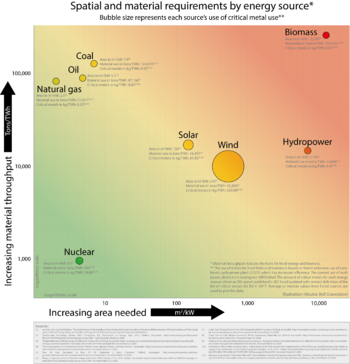User:David MacQuigg/Sandbox/Energy, Land, and Materials
The transition from fossil fuels to low-carbon energy sources will require enormous dedication of land and materials.[1] Cost projections based on current prices may be naive, if our use of these resources approaches any limits, planetary or geopolitical. This article is a summary of the land and material requirements for various energy sources.
Land use can be simply stated as square meters per kilowatt (m^2/kW) where kW is the rated maximum output of the energy source. This leave out important factors, such as capacity factor (the percent of maximum power delivered as a long-term average). Material requirements can be stated as metric tonnes (1000 kg) per terawatt-hour (t/TWh). For fuels, this is simple. For construction materials this measure requires an assumption about the lifetime of the power source, and ignores the possibility of recycling materials at end-of-life. Nevertheless, these two measures are a good starting point for discussions of our energy future.
Further Reading
The Role of Critical Minerals in Clean Energy Transitions, IEA (2021).
Quadrennial Technology Review 2015
Department of Energy, USA. Chapter 10 has charts and tables summarizing material requirements for various energy sources.
Nuclear Fuel Cycle Overview, World Nuclear Association, Updated April 2021, Section: Material balance in the nuclear fuel cycle has tables showing annual material requirements typical for a 1000 MWe nuclear power reactor.
Area and Material Consumption, Jonny Hesthammer, 2020. A review of various energy sources and a chart showing land and material requirements, including critical materials.
Notes and References
- ↑ See Energy policy and global warming for an estimate of total power required to decarbonize our planet, including electric power, fuels for transportation, and heat for industrial processes.
